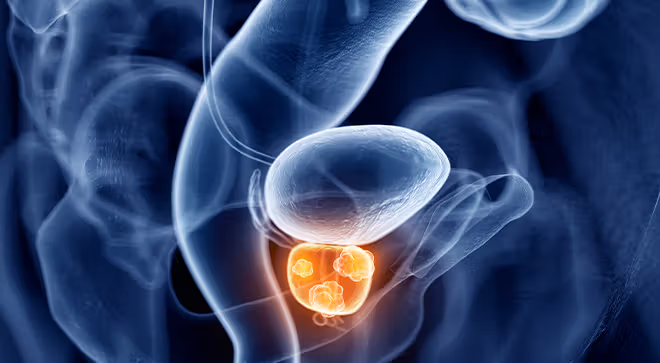Proteins, Cell Patterns May Explain Prostate Cancer Therapy Resistance
Researchers have found that a deeper look at proteins and cells may help explain why prostate cancer tumors often become resistant to hormone therapy.

Researchers found that looking at cell patterns and proteins may help determine a way to target prostate cancer tumors resistant to hormone therapy and open new dialogue regarding more effective treatments, according to a news release.
Hormone therapy for prostate cancer — also known as antiandrogen therapy — is a common treatment approach that blocks the action of androgens, or male hormones, in the body to prevent the growth of cancer cells. These androgens, including testosterone, bind to androgen receptors, which are a type of protein, found on prostate cancer cells and cells on other tissues, according to the National Cancer Institute.
However, it is common for patients receiving hormone therapy to become resistant, which causes the cancer to come back and progress, according to the news release.
“Identifying metabolic alterations and understanding patterns in cancer cells could be a critical component to developing new cancer treatments,” said Andrew Goldstein, associate professor of molecular, cell and developmental biology and urology at the David Geffen School of Medicine at UCLA, in the news release.
“New technological advances are giving us insight into actually how these tumors are breaking down their nutrients — known as cancer metabolism — to help them grow. And we might be able to harness or exploit that biology to make tumors more treatable,” Goldstein said.
In a study published in Nature Cell Biology, the researchers evaluated a process in which prostate cells change into a different type of cell, affecting the way it responds to treatment. The prostate contains two main types of cells: basal and luminal cells. Of the two cells, it is more common for the cancer cells to appear as luminal cells when the cancer grows, according to the study authors.
Goldstein, also the senior author of the study, noted in the news release that luminal cells are “more treatable” when the tumor is very luminal, and when it is less luminal, the tumor is more difficult to treat and becomes more resistant to therapy.
READ MORE: Testosterone Recovery Improves Quality of Life After Prostate Cancer
Researchers also determined that when basal cells evolve into luminal cells, changes in the cell metabolism may alter the cell’s “genetic instructions” regarding how the cells develop and respond to treatment.
Specifically, the researchers found that it is possible to change the cell behavior when blocking a particular part of cell metabolism, called mitochondrial pyruvate carrier, and adding the substance, lactate.
“The study highlights the importance of considering how altering cell metabolism could impact prostate cancer and its response to treatment,” said Jenna Giafaglione — first author of the study, a graduate student in UCLA’s molecular biology interdepartmental program and member of both the Goldstein lab and the lab of Paul Boutros, director of cancer data science at the UCLA Jonsson Comprehensive Cancer Center — in the release. “If we know that certain aspects of metabolism are promoting a resistant phenotype, then we can go after new targets in those resistant tumors,” she said.
Another study, published in Cell Reports, delved into the way prostate cancer cells respond to a blocked androgen receptor pathway. Goldstein, also the senior author of this study, and his team of researchers analyzed how cancer cells alter the way they produce energy and found that the way cells start depended on a particular type of energy inside the mitochondria.
A protein, MYC, also played a significant role in the way prostate cancer tumors respond to and resist therapy. The study’s researchers established that when MYC activity decreases because of hormone therapy, the cells heavily rely on their mitochondria to survive.
When the activity of the MYC does not decrease, the cells become resistant to treatment and are no longer reliant on their mitochondria, the study determined. The researchers also noted that when the MYC activity was boosted, energy production changed and ultimately made the cancer cells less sensitive to protein inhibitors.
“This study teaches us about treatment response and also suggests that if we could find the right combination of therapies, for example, to use hormone therapy initially, and then to use some kind of secondary therapy that influences the mitochondrial behavior, we might be able to reduce disease progression and recurrence,” said Goldstein in the news release.
For more news on cancer updates, research and education, don’t forget to subscribe to CURE®’s newsletters here.
Dickey Betts Died, ‘Shopaholic’ Author Announces Cancer Diagnosis and More
April 19th 2024From the Allman Brothers Band’s singer Dickey Betts dying after a cancer diagnosis to the “Shopaholic” author announcing her glioblastoma diagnosis, here’s what is happening in the cancer space this week.
Read More